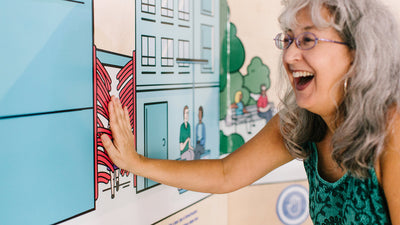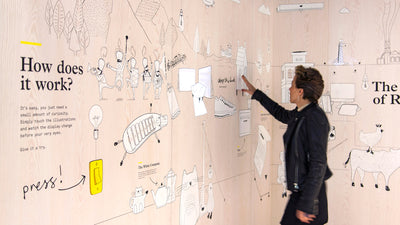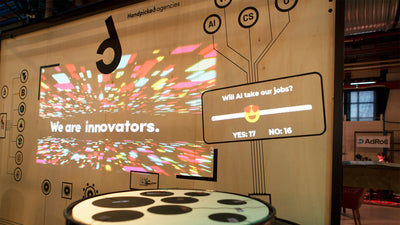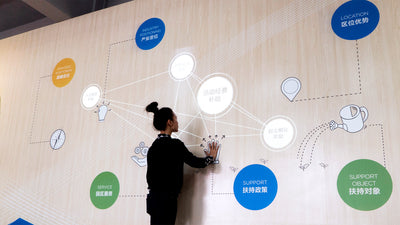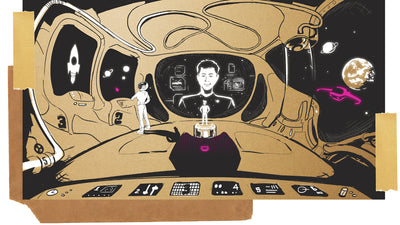Enfield E8000 - An Engaging Interactive Wall For A Greek Industrial Museum

An interactive touch wall combining projection mapping and augmented reality, telling a story of industrialization in Greece Industrial Museum.
Interactive touch and video walls have been incorporated in many museums with the aim to enhance the visitor experience and create an engaging outcome. A touch wall can combine different interaction techniques, technologies and styles in terms of visitor-exhibit interaction and social collaboration in the museum or public settings.
These installations are usually large in size and expensive, while their typical use is to present generic content about the museum. As a result, they may not be easily set-up at multiple locations inside a museum and serve the purpose of just presenting narratives about particular exhibits.
i-Wall is an affordable touch surface built from off-the-shelf components and technologies. It has been designed for the Syros Industrial Museum in Greece and presents a narrative about a particular exhibit, the Enfield E8000, which is the first electric car that reached small-scale production in 1973.
It was designed in the context of the undergraduate course ''Interactive Systems Design'', of the Department of Product and System Design Engineering, Polytechnic School of the University of the Aegean, Syros, Greece.
The team got inspired by the Electric Paint's potential, which enabled them to create a relatively low cost, yet high-quality interactive display that would improve the users’ experience inside the museum.
There's also a scientific publication on the subject: i-Wall: A Low-Cost Interactive Wall for Enhancing Visitor Experience and Promoting Industrial Heritage in Museums.
The interactive touch wall provides information to visitors about the concept, the design, the problems, the creators and the socio-political context related to the exhibit, in an interactive and intuitive way. It also allows visitors to appreciate the interior of the car as well as its functions via augmented reality (AR) technology. The design of i-Wall combines interactive storytelling, animations and projection mapping with smart tools such as conductive paint, the Touch Board and AR.
To create this video wall, they used a wooden surface, a Touch Board, Electric Paint, a short-throw projector, wires with alligator clips, nails, wiring, a laptop, a tablet and a speaker.
The animations projected on the wall were created with Adobe After Effects and Illustrator. The projection mapping on the wooden surface was achieved via MadMapper, while the coding of the touchpoints was done using the Arduino IDE software.
The project has an additional augmented reality application, so the visitors can interact with a 3D model of the car and gain further information about it. Four different software applications were used for the completion of the app. All the functions and information were implemented on Unity programme.
Augmented reality was achieved through the service of Vuforia, while the connection with the tablet was made using Android Studio. Lastly, the 3d model of the car was created on Cinema 4D by Maxon. To be able to achieve clear and polished shapes, they used stencils and the conductive paint was applied with a paintbrush no 8.
The creation of the touch wall was a complex process. The journey begins when the users choose to watch something by touching a button, and in this case, the team focused on the touch, thus eliminating the button and replacing it with touchpoints instead. Their aim was always to have a simple yet interesting interaction with the visitor and it was easy to achieve this with conductive paint.
Since the main interaction was through touching and having in mind that they aimed for an aesthetic of the flat design, both the technology and the means used, had to be able to support the audiovisual material and the projection mapping without adding any extra or external sensors.

In order for the touch display to work, the Touch Board was the best solution, because it's compatible with the Arduino software. This particular board gave them the opportunity to turn an ordinary wall into an interactive surface. This is possible because the board has certain sensors that respond when they are connected or painted with conductive paint. When a surface is painted with Electric Paint, it gets transformed into a touch “button”.
Indeed, the simple and interactive connectivity of the touch wall, for the Enfield E8000, was achieved largely due to the fact that the touchpoints between the visitor and the “wall” (sensor, button or screen) where replaced by the conductive paint.
Throughout the process of research, design and evaluation, the team realised that there is a need for a different and more participatory approach to the design of interactive systems for museums, exhibitions, product presentations, services etc.
In particular, the i-Wall contributes to a more experiential and engaging experience. A significant feature of the system is the combination of navigation, the sense of touch, sound and observation of the narration as it unfolds. The flow of storytelling directs users as the element of surprise remains throughout the interaction with the display.
Finally, i-Wall is flexible, as it can incorporate different means of interaction, while it can also be adapted to any space when designed appropriately.
Images & Video: Christina Gkiti, Eirini Varia, Chrysi Zikoudi, Athina Kyrmanidou, Io Kyriakati, Spyros Vosinakis, Damianos Gavalas, Modestos Stavrakis, Panayiotis Koutsabasis
We love it when you share your projects! Post your project on Instagram, YouTube, Vimeo, or Twitter, and make sure to tag @bareconductive or use #bareconductive. You can also send your videos and photos to info@bareconductive.com. Submit your project for a chance to be featured and you'll also receive 20% discount.


